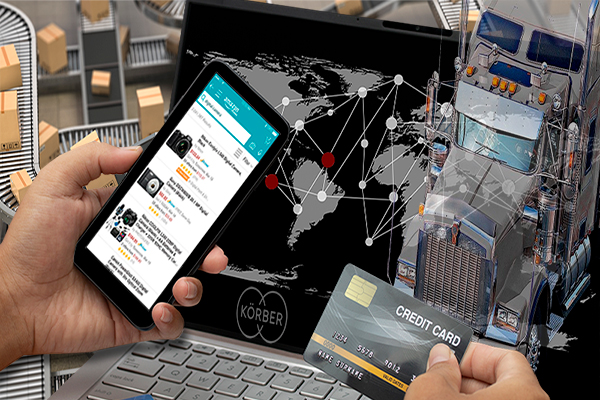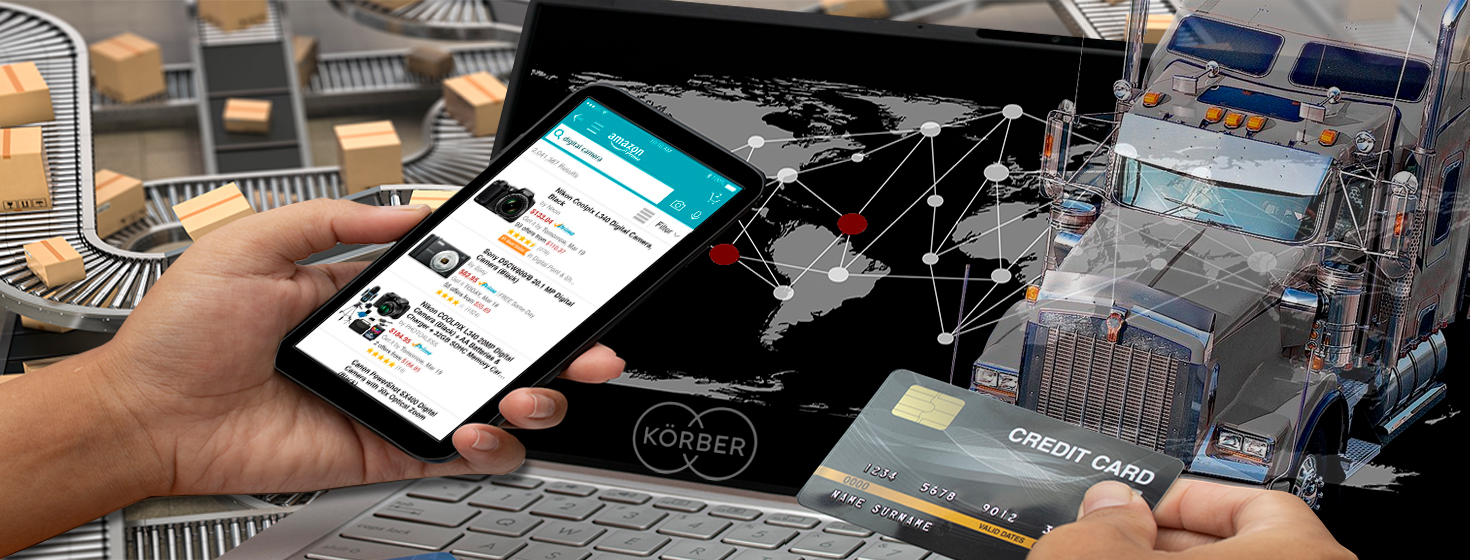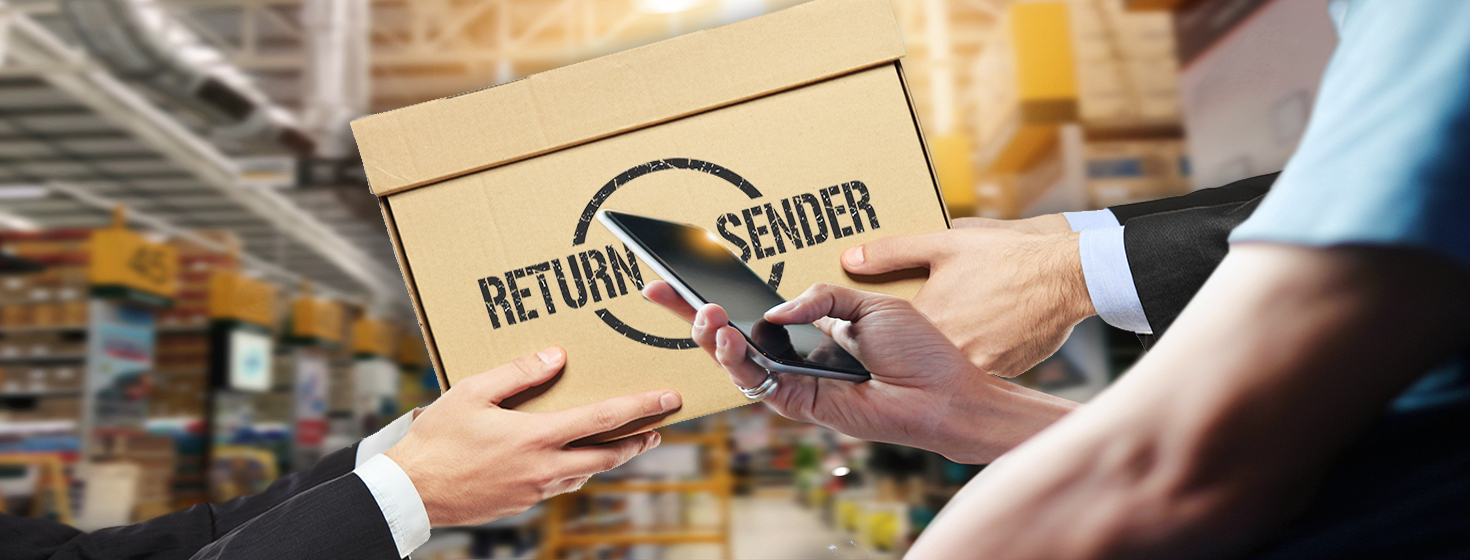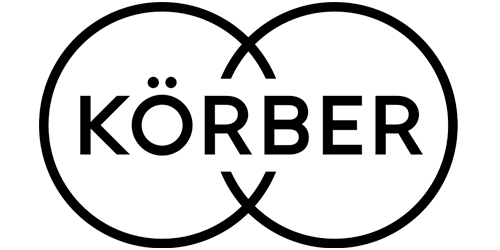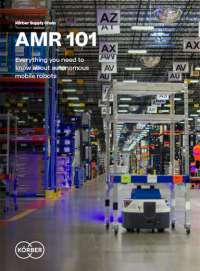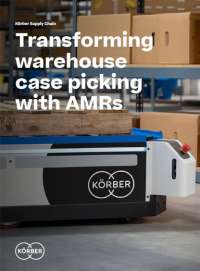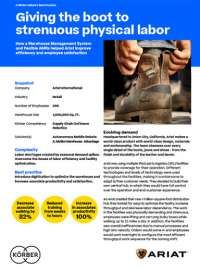Accelerating the Shift Toward Online Shopping
Business leaders and consumers alike have observed the ubiquity of ecommerce brought on by the COVID-19 pandemic. At this juncture, that is not news.
Well, how about this: According to IBM’s U.S. Retail Index, the coronavirus accelerated the shift toward online shopping - and away from brick-and-mortar - by about five years.
This news may be good for a company’s top line; however, many supply chain leaders are struggling to cope with the tremendous pressure this surge has put on their internal operations, customer service, and delivery partners.
“Both manufacturers and retailers, faced with ecommerce volumes that no one anticipated until 2025, are trying to meet this outsized demand with networks that were not prepared to handle this much volume this soon for such an extended period.”
So then, the questions on many minds are these: How can existing supply chains rapidly mature to the same five-year future level? And how can a business rise to the current challenges with only the resources at hand?
Like most supply chain decisions, the answers to these questions are found at the intersection of speed and cost. In the realm of ecommerce, pioneers like Amazon relentlessly favored speed. That worked fine for brick-and-mortar retailers when their ecommerce volumes were in the single digits as a percentage of sales. However, given that today’s order volumes are likely here to stay, profitability is a mandatory consideration from here on out.
Last-Mile Delivery
A simple, back of the envelope SWOT analysis will tell you that retailers with brick-and-mortar stores have an obvious advantage over their direct-to-consumer (D2C) counterparts: their physical store footprint. Several last-mile delivery innovations have spawned from this advantage, including buy online, pick-up in-store and buy online, ship from the store. Another model that is growing in popularity for both traditional and D2C retailers is the micro-fulfillment center (also referred to as urban distribution centers).
Buy Online, Pick-Up In-Store
Buy online, pick-up in-store (BOPIS), and the more social distancing-friendly adaptations like “curbside pickup” have seen wider adoption in recent years, but particularly since the start of the pandemic. BOPIS is relatively inexpensive for traditional retailers as the last mile delivery cost is split with the customer.
There are various ways to implement this approach. Some retailers like Walmart and Kroger use defined pickup windows to manage staffing and navigate peak hours, whereas Target fulfills an order within four hours and gives the customer up to 48 hours to pick it up. In either case, the goals are to limit capacity at busy times, incentivize off-peak traffic and promote load-balancing. Store managers can also change capacity limits in response to daily operational constraints, observed customer demands, or both.
Buy Online, Ship from the Store
Buy online, ship from the store (BOSS) involves a higher overall level of commitment and expenditure from retailers. However, it can have a much more profound effect in the areas of inventory and transportation optimization. Retailers can search their entire network for available stock and simultaneously identify which location has the lowest cost shipping option. Zone skipping and regional sorting centers mean that the closest location is not always the cheapest. In instances where the order can be fulfilled (at least partially) from a local store, same-day delivery can be an added service via on-demand providers like Instacart or Shipt, as well as regional carriers like Lasership or AxleHire.
Stores can initially implement BOSS on an ad-hoc basis by setting aside space for order picking, preparation, and packaging. Retailers can choose to distribute BOSS activity across all their locations or only specific ones in a given geographic area. As the demand for BOSS increases, a dedicated space can be created by appropriating square footage from the sales floor without reducing backroom capacity.
For both BOPIS and BOSS, the revenue should be part of that store’s P&L to incentivize high-performance standards and demonstrate a company’s commitment to servicing the digital channel. In some retail organizations, these two nascent modes still languish in an off-P&L “digital teams” designation under the purview of corporate offices. Unmotivated store management may understandably short-staff the digital team, leading to slow service and eventually, avoidable corporate intervention.
Micro-Fulfillment Centers
Micro-fulfillment centers (MFC) or urban DCs allow any ecommerce retailer to provide an analog to BOPIS and BOSS in the absence of a retail location. Frequently built with a customer-facing front end, these fulfillment points create the capability for same-day delivery and other levels of service in a dense city environment that can’t - or won’t - support a big-box store.
This delivery model is worth investigating and assessing for businesses with thousands of same-day orders in a single geographical area. Without this sustained volume, an MFC is typically too expensive to implement and will have a low ROI.
Improving Operations Within the Four Walls
Across all delivery models, several upstream opportunities can propel your supply chain forward. You can find some of the fastest, most cost-effective improvements inside the four walls of your existing distribution centers (DC) or fulfillment centers (FC).
Flexible Slotting Configurations
Slotting is most often done at the SKU-level. For ecommerce, however, you should slot at a category level - shoes, hats, kitchen appliances, etc. Assign pickers to the categories they are most familiar with - and therefore, the most efficient pickers of. This method optimizes picking speed per category as well as per order.
Seasonality should also be considered, along with promotions, as products should be slotted for timely access and fulfillment. However, if your demand does not exhibit a strong Pareto - or your order composition does not display a clear trend - you can skip such exercises. Random order is actually the best answer in those situations.
Single Unit Orders
Get these orders out quickly. If an item is designed for “pick to polybag,” send it directly to the packing station. There is no point in sending a single unit on a five-mile journey through your order-consolidating sorters. Track non-optimal assignments regularly “Non-optimal assignments” to an FC typically occur because of inventory shortages or because the logic built into your order management system attempts to avoid split shipments. They are frowned upon by transportation managers since they “un-optimize” the initially optimized order journey. In these instances, it is best to look at the total delivered cost - including inventory, working capital, risk of obsolescence, and storage costs - before deciding whether to increase inventory. Split shipments or non-optimal assignments may not be as detrimental as you think.
Picking Technology
Automation and robotics are more of a medium- to long-term implementation for operational improvements. When considering such an investment, there are some variables to keep in mind. The solution under consideration should do at least one of these three things:
- decrease the click-to-ship interval;
- decrease labor by either reducing walking time or eliminating a position; and/or
- significantly increase pick accuracy.
Each type of automation (whether goods-to-person such as GreyOrange, inVia Robotics or Caja Robotics, or process robots like Locus or Six Rivers) has its sweet spot. However, they may require you to tear down your current racks and buy thousands of totes. Others might have weight limits per pick and require specific aisle widths and/or turning radii. Keep in mind that automation solutions will hit their designed capacities - quickly and efficiently - but they won’t surpass it. “Throwing more bodies” at an automated process doesn’t work very well.
Third-Party Logistics Integrations
Integrating with a third-party logistics provider is often site-specific and riddled with cumbersome and unnecessary IT costs. If you decide to outsource your ecommerce channel - again, more of a long-term solution - select a 3PL that uses a single system across its network. This way, you’ll have access and visibility to every node allowing you to deploy inventory quickly (which is particularly helpful during peak times when any number of nodes may be attractive).
Third-Party Logistics (3PL) and Ecommerce - The Challenge | The Opportunity | The Solution
Optimizing Distribution Packaging
Packaging is another upstream improvement opportunity - both functionally for containment and protection as well as for its direct impact on the customer experience and indirect effects on supply chain costs (labor, storage, transportation, etc.).
Material Costs Versus Damage Costs
Design packaging with the intended supply chain in mind. In ecommerce, this means a significant increase in rough handling. Our experience has shown that an ecommerce shipment is subjected to three times more touches than a palletized shipment. For manufacturers, this means one of your biggest ecommerce challenges is making sure you adequately package your products for parcel shipping without excessive weight or cost.
Two end-of-line solutions worth considering for changing order patterns and smaller, more frequent orders are cartonization technology and on-demand packaging systems. These tools are useful for eliminating excess material waste and fine-tuning your box sizes in terms of size and weight for dimensional weight-based shipping and zone-based shipping for rate optimization.
Primary Packaging and Out-of-Box Experiences
Given the historical predominance of the brick-and-mortar channel, most primary packaging is designed to support merchandise. The growth of ecommerce has brought us to a tipping point where this standard is rightly being called into question.
For products sold exclusively through an online channel, design primary packaging for efficient and effective distribution (shipping-in-original-carton [SIOC], conveyability). For products that straddle both online and in-store channels, brand owners may want to consider leveraging an “ecommerce friendly” design as the default or having a dedicated ecommerce design that provides a trouble-free (and potentially shareable) unboxing experience. In many of these cases, the additional cost of packaging is offset by reduced handling and cartonization savings.
Securing Sufficient Transportation Capacity
Transportation, inarguably one of the biggest challenges of the 2020 holiday season, is another upstream opportunity for ecommerce improvements. As early as October 2020, the Big Three - FedEx, UPS, and USPS - announced that their networks were at capacity, a problem that only grew as the peak season wore on. While the overall North American freight market is pretty efficient in terms of aggregate supply and demand, the niche last-mile sector is increasingly unbalanced.
Regional and Local Carriers
Securing capacity with regional parcel carriers is the first step to filling the gap left by the Big Three. You run a region-specific sourcing event to unlock this capacity or partner with a regional 3PL. In either case, you’ll want to ensure that detailed tracking capabilities are enabled since this is what consumers have come to expect. Technology providers like eTrac can provide multiple bridges between your systems and various regional carriers, effortlessly integrating them into your processes and providing transparency for your customers.
You may also want to consider adding smaller, local carriers to your portfolio, especially for same-day and next-day deliveries in large metro areas. Local carriers tend to be around 50% cheaper than parcel providers for same-day service. Plus, their reach is much larger than point-to-point companies like DoorDash or Uber and they work in a parcel-like fashion, offering predetermined delivery and pickup schedules, for instance.
Special Services For Fragile and Oversized items
Suppose your product portfolio contains fragile or big and bulky items. In that case, you’ll need to coordinate with white-glove carriers that have vehicles equipped for, and staff who specialize in, full-service deliveries. They typically employ box trucks with liftgates facilitating the delivery of large bulky items to residences - either to the front door or sometimes inside if installation or setup is involved. Back-office staff should also have the tools to coordinate appointments and effectively carry out two-way communications with drivers and customers.
Planning for Returns
Downstream from delivery is perhaps the most overlooked improvement opportunity: reverse logistics. In an ecommerce environment, returns are inevitable. For your ecommerce channel to be profitable, your organization needs a plan for mitigating returns and dealing with those that are unavoidable. Integrate the returns process into the rest of your logistics operations to reduce excess costs and best position the product for resale.
Minimizing Returns
Yes, returns are inevitable, but companies should still do their part to mitigate them in the first place. As part of the reverse logistics process, companies should seek to understand the main causes of returns as well as what return methods their customers prefer. Wrong size? Add product images and videos to the product description. Item doesn’t work? Provide technical support to troubleshoot the issue. Late delivery or no longer needed? Create a positive return experience to encourage them to buy again in the future.
Rise of Bracketing
Many people buy products just to try them. However, a growing number of savvy consumers have ventured into “bracketing.” This practice is familiar in the fashion and apparel space and it exists outside of the ecommerce channel. Say a customer is buying the latest New Balance cross trainers, but they’re unsure of the fit. They typically wear a size 10, but they go ahead and buy the 9.5 and 10.5 as well to see which fits best, and then return the unwanted items. Nowadays, this behavior manifests around everything from shoes to coffeemakers.
Optimizing the reverse logistics process - most commonly done by putting in place a convenient Buy Online, Return in Store (BORIS) process - is the only way to mitigate the effects of bracketing. It may also help to know that the most frequent bracketers are often some of your best customers. Bracketing is a cost of doing business. The best defense is to get returned items back on the shelf quickly.
Leverage BORIS to Expedite Inventory Repositioning
BORIS is a no-brainer for companies with existing retail locations. The in-store delivery model keeps inventory near the point-of-sale, meaning returned items can be repositioned for sale almost immediately. Exclusively D2C retailers can still take advantage of the efficiencies of the BORIS method by integrating with the customer-facing access points of last-mile providers, such as FedEx Office locations.
The benefit for the customer is an instant refund and consolidated return parcels for you. Consolidation not only decreases reverse logistics parcel costs but also expedites the disposition of products. The best integrations ensure that the return label generated at the access point reduces return processing at FCs. In our experience, around 25% of the time spent processing returns is dedicated to unpacking the customer’s packaging. Having a BORIS access point for returns avoids that time-suck entirely.
Factors in Reverse Logistics Capacity
Adding this needed capacity to your regular sourcing events creates savings opportunities for you as well as backhaul opportunities for carriers. Just like their forward counterparts, reverse logistics volumes and lanes should be forecast during the bid preparation phase. Consider these questions: How many days from the purchase date can the item be returned? If the merchandise is big and bulky, will a pick-up need to be scheduled? How are returns processed and repurposed for resale? In our experience, returns account for 5% to 10% of all ecommerce volumes, so this is not an inconsequential amount of capacity.
The growth of ecommerce has been heralded for quite some time; however, few of us predicted it would take a once-in-a-century pandemic to kick things into high gear. As a result, our collective directive is to figure out how to serve tomorrow’s ecommerce demand with today’s supply chains. Distribution operations, packaging, transportation, and reverse logistics hold many improvement opportunities for companies on this journey.
Ecommerce is a Moving Target
NASDAQ estimates that by 2040, 95% of all purchases will be facilitated by ecommerce. Luckily, the lessons that supply chain leaders learn from today’s challenges will provide a strong foundation for future innovation and growth.
About the Authors
Vikas Argod is a director in Chainalytics’ Supply Chain Operations practice. He can be reached at [email protected]. Kyle Ous is a senior manager in the Packaging Optimization practice. He can be reached at [email protected]. Bryan Wyatt is a principal in the Transportation practice. He can be reached at [email protected].
Related Resources
Third-Party Logistics and Ecommerce
In this white paper, we describe how 3PL providers can use supply chain technology to address the challenges of ecommerce. Download Now!
Using Innovative Technology to Cope With Seasonal Peaks and Returns
In this whitepaper you will learn how technology can help you with; seasonal peaks, handling returns, labor shortages, and onboarding cost-management. Download Now!
More Resources on Ecommerce
Related Article: Reducing Costs of Returns in the Omnichannel Supply Chain
Article topics
Email Sign Up

